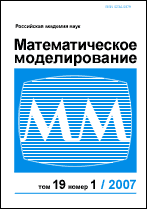|
This article is cited in 1 scientific paper (total in 1 paper)
Pandemic forecasting by machine learning in a decision support problem
V. A. Sudakova, Yu. P. Titovb
a Keldysh Institute of Applied Mathematics of Russian Academy of Sciences
b Plekhanov Russian University of Economics
Abstract:
The paper proposes an approach that allows, based on fairly simple models, to propose an approach to predicting the decision of the governing bodies on the number of necessary medical centers to combat the pandemic. This approach is based on the idea that the decision to open a new center is not made immediately with the overflow of existing centers, but with some delay. Thus, the government is trying to minimize the risks of unnecessary opening and makes this decision, realizing that the congestion of existing centers will not end in the short term. This decision can be predicted by training the model on historical data obtained from open sources. We have developed a model that can be trained on historical data and allows forecasting the number of medical centers based on a forecast of the number of hospitalized patients for 14 days. Approaches are proposed for predicting the number of hospitalized patients with accuracy sufficient for the model to predict the number of medical centers. The models were tested on data from open sources obtained for the Ryazan region. For the forecast model for the number of open medical centers in the Ryazan region, penalty functions are determined and the corresponding coefficients are calculated.
Keywords:
decision support, predicting the number of medical centers, resource management, penalty function.
Received: 20.04.2022
Revised: 20.04.2022
Accepted: 12.09.2022
Citation:
V. A. Sudakov, Yu. P. Titov, “Pandemic forecasting by machine learning in a decision support problem”, Matem. Mod., 34:11 (2022), 107–122; Math. Models Comput. Simul., 15:3 (2023), 520–528
Linking options:
https://www.mathnet.ru/eng/mm4421 https://www.mathnet.ru/eng/mm/v34/i11/p107
|

| Statistics & downloads: |
| Abstract page: | 224 | | Full-text PDF : | 62 | | References: | 52 | | First page: | 11 |
|




 Contact us:
Contact us: Terms of Use
Terms of Use
 Registration to the website
Registration to the website Logotypes
Logotypes







 Citation in format
Citation in format 
